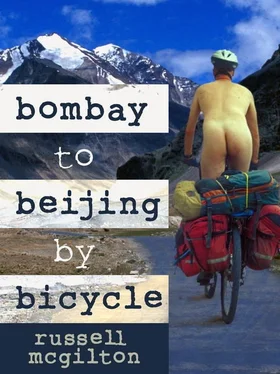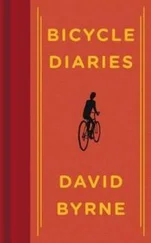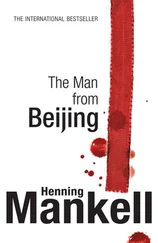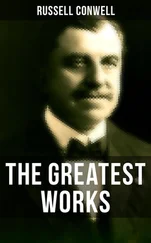I dodged workmen laying bricks on the road, and was forced onto the pavement and walked with the bike. A woman, sitting with her hand open to passers-by, upon seeing me, grabbed at my shorts. I tried to keep walking but her nails caught in my shorts like blackberry thorns.
‘Ten rupees, sir. Ten rupees…’
I pulled out a bunch of rupee notes and my shorts were instantly released.
Office workers were busily marching off to lunch, and as I dodged swinging limbs and sweaty business shirts, it appeared that I was walking in the wrong direction. My only relief came as I walked through the Oval Maidan, a broad, parched park filled with enthusiastic young cricketers knocking cricket balls across its starkness.
Near Mumbai’s Churchgate Station throngs of passengers swam by. Across the current of faces, Tiffin boxes (silver tins with wire handles) were being stacked and carried on wooden barrows by men in cotton pyjamas and Nehru pillbox hats. These men were dabbawallahs (in local dialect, Marathi, dabba means ‘Tiffin carrier’; wallah means ‘man’), lunch-box couriers of the Mumbai Tiffin-Box Suppliers Association – a vestige of the British Raj. Every day, about 5000 dabbawallahs deliver approximately 170 000 lunches (prepared by housewives) from suburban households to schools, universities and offices across Mumbai. Apparently, dabbawallahs , despite many being illiterate, only make one mistake for every eight million lunches delivered!
I watched two dabbawallahs spear through the slowing traffic, bounce the barrow over a gutter and disappear around a building.
I got back on the bike and cut through onto Marine Drive on the west side of Colaba where the Arabian Sea met the bay. On the beach lay clumps of rags flapping in the wind. Some of these rags got up and walked around – people, no, whole communities, perhaps from the rural plains I would soon be cycling on, were living among plastic bags of blue ruin. Behind them, smog chalked across Back Bay, leaving shadows of Colaba’s hotels like a badly printed watercolour.
Parched from the acrid taste of exhaust, I stopped at a restaurant, sat down and ordered a juice. Shortly after, a frumpish woman entered and greeted the waiter with a kiss and a devilish smile, her green-and-white sari swaying around her. I thought this was odd, as I had not seen an Indian woman greet any man in this way in the four days I had been here. And there was a reason for this, I soon discovered: she was a man or, rather, I think had been. She was a hijra – a caste of transvestites and eunuchs.
‘Give me some money,’ came a deep, smooth, yet feminine voice. She smiled at me, flirting a little.
‘Why?’ I asked.
‘Tsk!’ Her face twisted, taking her large smile with it. ‘You give me some rupees.’
‘What for?’
‘Tsk! Give me money!’
‘But what have you done?’
‘ Baksheesh ,’ she said, and her large smile returned with a proffered hand adorned with gold rings and bangles.
‘No.’
‘Tsk! You give me no money!’ This time she hissed like a cat and made a strange claw with her fingers.
‘Oh, dear. Am I cursed now?’ I smiled, but her eyes were like razors and she shooed me away as if I were an overweight moth.
I was lucky I hadn’t been spat on or, worse, flashed at by his/her missing bits. Hijras usually earn their living by turning up at weddings, births and other celebrations in the hope that their bad singing, dancing and vulgar habits will be put to a stop by a few handy bribes. If none of that paper note stuff comes their way, eunuchs will curse newborn babies, spit ochre-coloured paan juice on newlyweds or sometimes go as far as taking their own clothes off.
Although it’s unclear how many hijras there are in India, the figure has been put at anything between 100 000 and 1.2 million – in other words, nobody has the foggiest. Hijras are generally either those born with deformed genitalia, hermaphrodites, transsexuals or voluntary castratos, while others have allegedly been kidnapped, drugged and castrated against their will.
Interestingly, because hijras have an insider’s knowledge of local neighbourhoods (they always know in advance where a wedding will take place), some credit card companies now employ them as debt collectors. Somehow I can’t see that working particularly well in the East End of London: ‘Ya gonna show me ya wot ?’
I pushed up Malaba Hill through slivers of light, the sun trying to knife its way through the thick canopy of trees. At a junction, my guidebook got me lost, so I asked directions from a group of old men wearing Nehru hats and playing what looked to be Chinese chequers. They pointed further up the hill just as a kite snapped in front of my face; a gang of schoolchildren giggled and ran away with it.
I rode up through a lush tropical garden and arrived at a nondescript bungalow that I thought was the entry to the Towers of Silence. An old Parsi gentleman with a black silk cap and Lawrence Olivier air was circumspect about letting me go any further.
‘What do you want?’ he asked flatly.
I explained that, while I didn’t want to go into the Towers of Silence, I wondered if perhaps I could see them from afar.
‘Hmm,’ he held a stiff gaze. ‘Where are you from?’
‘Australia.’
‘Hmm. What are you doing with this bicycle?’
‘Cycling.’
‘From Australia! Good God!’ and, before I could interject to say ‘I’ve only done a few kilometres from Colaba’, he was jabbering at his colleagues, who made lots of ‘ooh, aah!’ sounds and crowded around me.
‘Oh, very far! You must be a strong man.’
‘No, I—’
‘Much hardship for you. Yes, sir. You must be such determination.’
He then palmed me off to a young man named Benjamin.
‘He will show you the towers. Follow him.’
‘They’re much smaller than I imagined them to be,’ I said.
‘Yes, they are small.’
I leant over the square model of the towers; clearly such interest in Parsi funeral rites had forced the Parsis to make a proxy. Well, that and the fact that a Time Life photographer had recently scaled a building opposite the towers and published colour photographs of a funeral, vultures and all. The Parsi community was understandably outraged.
‘In here,’ Benjamin said, pointing to four wells that surrounded the structure, ‘it flushes the remains. The blood goes down this chamber into the wells and is filtered. The earth cannot be defiled by the dead.’ He shook his finger. ‘Nothing goes into the sacred elements – water, fire, air and earth.’
This isn’t strictly true. There have been complaints from local residents finding the odd dismembered finger in their washing (‘Ere? What’s that finger doin’ in me undies?’), and of other titbits landing on passers-by as the vultures fly past looking for a private place to eat.
At the time of my visit, not all was well in the Towers of Silence. Corpses weren’t being eaten. A type of sickness, Benjamin told me, was causing the vultures to die. It was in fact due to the use of Diclofena, an anti-inflammatory used on cattle. Vultures would eat the carcass, which in turn would cause their renal system to fail. The decimation of vultures was not unique to Mumbai but right across the Indian-subcontinent.
To remedy the lack of available vultures, the Parsi panchayat (council) had installed giant solar reflectors to hasten the process of corpse decomposition, as well as an ozone generator to help combat the stench. Some reformists within the Parsi community were opting for burying the dead while an aviary was being built to breed vultures in captivity.
Читать дальше












